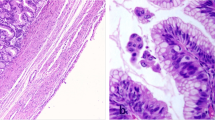Abstract
Background
Low-grade appendiceal mucinous neoplasm of uncertain malignant potential are poorly understood lesions characterized by extraluminal mucin or fibrosis with neoplastic cells confined to the appendiceal lumen. The purpose of this study is to investigate the clinical and pathologic parameters of these lesions to optimize our understanding and management of these tumors.
Methods
Subjects with these tumors were identified from the appendiceal tumor databases at the University of Texas MD Anderson Cancer Center. Univariate and multivariate Cox proportional hazards regression analyses assessed relationships between clinicopathologic variables [including age, gender, margin status and serum levels of the tumor markers carcinoembryonic antigen (CEA), cancer antigen (CA)-125, and CA19-9] disease-free survival, postrecurrence survival and overall survival.
Results
Ninety-eight subjects with this disease were identified. Most patients did not experience disease recurrence after initial appendectomy. At last follow-up, 25 (26 %) had disease recurrence or died. Of the 20 patients who had disease recurrence, 5 (25 %) died, and 15 (75 %) were alive. Disease-free survival was significantly reduced with positive margin status (p = 0.02) and elevated serum levels of CEA (p < 0.001), CA19-9 (p = 0.01), or CA-125 (p = 0.002) at the time of appendectomy. The median postrecurrence survival time was 4.7 years and the 5-year postrecurrence survival rate was 41 % (standard error = 18 %).
Conclusions
Patients with Low-grade appendiceal mucinous neoplasm of uncertain malignant potential who have negative margins and normal tumor marker levels have a lower risk for recurrence. In these patients, expectant management is sufficient. Elevated tumor marker levels at the time of appendectomy marks an increased risk of recurrence or death and signals the need for closer monitoring or intervention.


Similar content being viewed by others
References
Connor SJ, Hanna GB, Frizelle FA. Appendiceal tumors: retrospective clinicopathologic analysis of appendiceal tumors from 7970 appendectomies. Dis Colon Rectum. 1998;41:75–80.
McCusker ME, Cote TR, Clegg LX, et al. Primary malignant neoplasms of the appendix: a population-based study from the surveillance, epidemiology and end-results program, 1973–1998. Cancer. 2002;94:3307–12.
Misdraji J. Appendiceal mucinous neoplasms: controversial issues. Arch Pathol Lab Med. 2010;134:864–70.
Panarelli NC, Yantiss RK. Mucinous neoplasms of the appendix and peritoneum. Arch Pathol Lab Med. 2011;135:1261–8.
Gibbs NM. Mucinous cystadenoma and cystadenocarcinoma of the vermiform appendix with particular reference to mucocele and pseudomyxoma peritonei. J Clin Pathol. 1973;26:413–21.
Higa E, Rosai J, Pizzimbono CA, et al. Mucosal hyperplasia, mucinous cystadenoma, and mucinous cystadenocarcinoma of the appendix. A re-evaluation of appendiceal “mucocele.” Cancer. 1973;32:1525–41.
Prayson RA, Hart WR, Petras RE. Pseudomyxoma peritonei. A clinicopathologic study of 19 cases with emphasis on site of origin and nature of associated ovarian tumors. Am J Surg Pathol. 1994;18:591–603.
Cuatrecasas M, Matias-Guiu X, Prat J. Synchronous mucinous tumors of the appendix and the ovary associated with pseudomyxoma peritonei. A clinicopathologic study of six cases with comparative analysis of c-Ki-ras mutations. Am J Surg Pathol. 1996;20:739–46.
Chuaqui RF, Zhuang Z, Emmert-Buck MR, et al. Genetic analysis of synchronous mucinous tumors of the ovary and appendix. Hum Pathol. 1996;27:165–71.
Ronnett BM, Shmookler BM, Diener-West M, et al. Immunohistochemical evidence supporting the appendiceal origin of pseudomyxoma peritonei in women. Int J Gynecol Pathol. 1997;16:1–9.
Teixeira MR, Qvist H, Giercksky KE, et al. Cytogenetic analysis of several pseudomyxoma peritonei lesions originating from a mucinous cystadenoma of the appendix. Cancer Genet Cytogenet. 1997;93:157–9.
Szych C, Staebler A, Connolly DC, et al. Molecular genetic evidence supporting the clonality and appendiceal origin of pseudomyxoma peritonei in women. Am J Pathol. 1999;154:1849–55.
Young RH. Pseudomyxoma peritonei and selected other aspects of the spread of appendiceal neoplasms. Semin Diagn Pathol. 2004;21:134–50.
Seidman JD, Elsayed AM, Sobin LH, et al. Association of mucinous tumors of the ovary and appendix. A clinicopathologic study of 25 cases. Am J Surg Pathol. 1993;17:22–34.
Carr NJ, Sobin LH. Epithelial noncarcinoid tumors and tumor-like lesions of the appendix. Cancer. 1995;76:2383–4.
Carr NJ, Sobin LH. Unusual tumors of the appendix and pseudomyxoma peritonei. Semin Diagn Pathol. 1996;13:314–25.
Pai RK, Longacre TA. Appendiceal mucinous tumors and pseudomyxoma peritonei: histologic features, diagnostic problems, and proposed classification. Adv Anat Pathol. 2005;12:291–311.
Carr NJ, Sobin LH. Adenocarcinoma of the appendix. In: Bosman F, Carneiro F, Hruban R, Theise N, editors. WHO classification of tumours of the digestive system. Lyon: International Agency for Research on Cancer; 2010. p. 122–5.
Misdraji J, Yantiss RK, Graeme-Cook FM, et al. Appendiceal mucinous neoplasms: a clinicopathologic analysis of 107 cases. Am J Surg Pathol. 2003;27:1089–103.
Yantiss RK, Shia J, Klimstra DS, et al. Prognostic significance of localized extra-appendiceal mucin deposition in appendiceal mucinous neoplasms. Am J Surg Pathol. 2009;33:248–55.
Pai RK, Beck AH, Norton JA, et al. Appendiceal mucinous neoplasms: clinicopathologic study of 116 cases with analysis of factors predicting recurrence. Am J Surg Pathol. 2009;33:1425–39.
SAS Institute Inc. SAS/STAT, user’s guide, version 9. Cary, NC: SAS Institute; 2003.
Venables W, Ripley B. Modern applied statistics with S-PLUS. New York: Springer; 1999.
Kaplan EL, Meier P. Nonparametric estimation from incomplete observations. J Am Stat Assoc. 1958;53:457–81.
Cox DR. Regression models and life tables. J R Stat Soc B. 1972;34:187–220.
Chua TC, Moran BJ, Sugarbaker PH, et al. Early-and long-term outcome data of patients with pseudomyxoma peritonei from appendiceal origin treated by a strategy of cytoreductive surgery and hyperthermic intraperitoneal chemotherapy. J Clin Oncol. 2012;30:2449–56.
Youssef H, Newman C, Chandrakumaran K, et al. Operative findings, early complications, and long-term survival in 456 patients with pseudomyxoma peritonei syndrome of appendiceal origin. Dis Colon Rectum. 2011;54:293–9.
Dineen SP, Royal RE, Hughes MS, et al. A simplified preoperative assessment predicts complete cytoreduction and outcomes in patients with low-grade mucinous adenocarcinoma of the appendix. Ann Surg Oncol. 2015;22:3640–6.
Disclosure
The authors declare no conflict of interest.
Author information
Authors and Affiliations
Corresponding author
Rights and permissions
About this article
Cite this article
Fournier, K., Rafeeq, S., Taggart, M. et al. Low-grade Appendiceal Mucinous Neoplasm of Uncertain Malignant Potential (LAMN-UMP): Prognostic Factors and Implications for Treatment and Follow-up. Ann Surg Oncol 24, 187–193 (2017). https://doi.org/10.1245/s10434-016-5588-2
Received:
Published:
Issue Date:
DOI: https://doi.org/10.1245/s10434-016-5588-2




